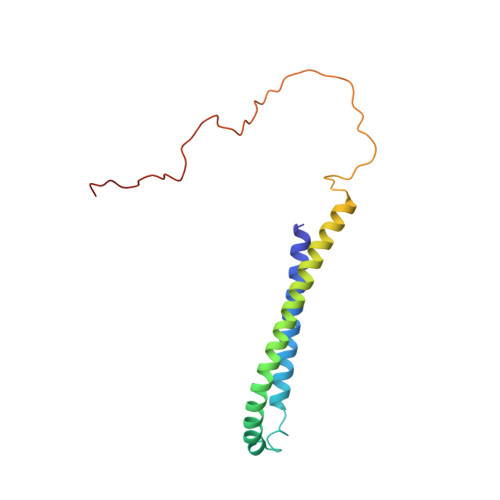A combinatorial NMR and EPR approach for evaluating the structural ensemble of partially folded proteins.
Rao, J.N., Jao, C.C., Hegde, B.G., Langen, R., Ulmer, T.S.(2010) J Am Chem Soc 132: 8657-8668
- PubMed: 20524659
- DOI: https://doi.org/10.1021/ja100646t
- Primary Citation of Related Structures:
2KKW - PubMed Abstract:
Partially folded proteins, characterized as exhibiting secondary structure elements with loose or absent tertiary contacts, represent important intermediates in both physiological protein folding and pathological protein misfolding. To aid in the characterization of the structural state(s) of such proteins, a novel structure calculation scheme is presented that combines structural restraints derived from pulsed EPR and NMR spectroscopy. The methodology is established for the protein alpha-synuclein (alphaS), which exhibits characteristics of a partially folded protein when bound to a micelle of the detergent sodium lauroyl sarcosinate (SLAS). By combining 18 EPR-derived interelectron spin label distance distributions with NMR-based secondary structure definitions and bond vector restraints, interelectron distances were correlated and a set of theoretical ensemble basis populations was calculated. A minimal set of basis structures, representing the partially folded state of SLAS-bound alphaS, was subsequently derived by back-calculating correlated distance distributions. A surprising variety of well-defined protein-micelle interactions was thus revealed in which the micelle is engulfed by two differently arranged antiparallel alphaS helices. The methodology further provided the population ratios between dominant ensemble structural states, whereas limitation in obtainable structural resolution arose from spin label flexibility and residual uncertainties in secondary structure definitions. To advance the understanding of protein-micelle interactions, the present study concludes by showing that, in marked contrast to secondary structure stability, helix dynamics of SLAS-bound alphaS correlate with the degree of protein-induced departures from free micelle dimensions.
- Department of Biochemistry & Molecular Biology, Zilkha Neurogenetic Institute, Keck School of Medicine, University of Southern California, 1501 San Pablo Street, Los Angeles, California 90033, USA.
Organizational Affiliation:
















